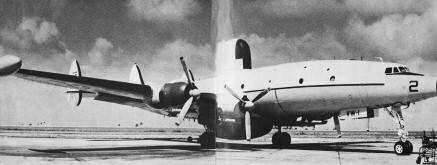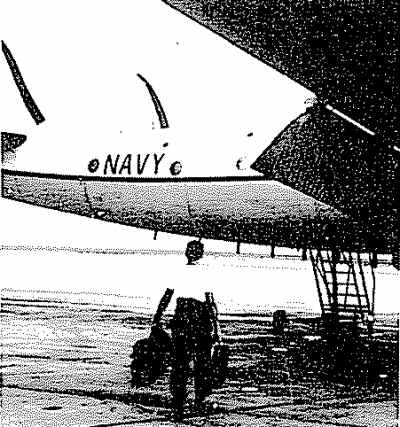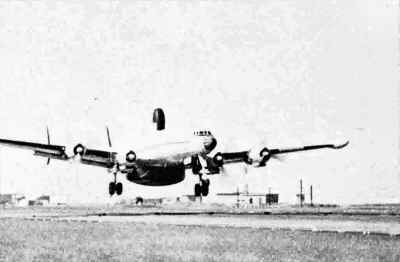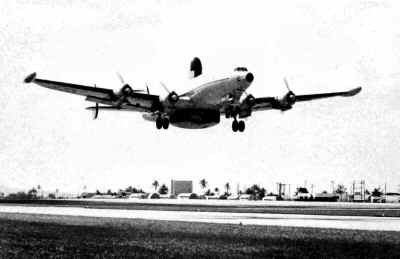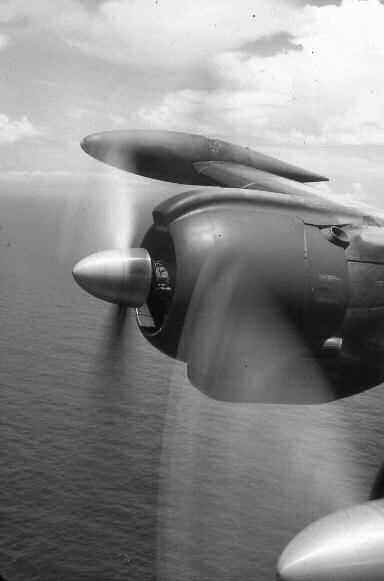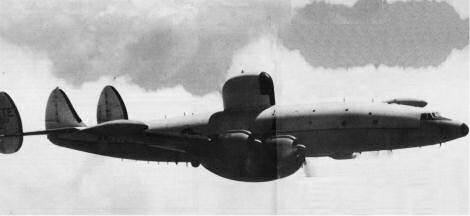 Cruising over cumulus buildups off the coast of Japan TE-11 monitors weather fronts with
its complex array of radar scanners. Flying weatherman sniffed Pacific skies to provide data on possible
typhoon and storm conditions valuable not only to the fleet, but to all civilians residing in the Pacific
Basin.
Cruising over cumulus buildups off the coast of Japan TE-11 monitors weather fronts with
its complex array of radar scanners. Flying weatherman sniffed Pacific skies to provide data on possible
typhoon and storm conditions valuable not only to the fleet, but to all civilians residing in the Pacific
Basin.
PEOPLE STOP by the picture on the wall of my office, to ask, "What's that?," and the answer is, "it's a picture of my first typhoon." This reply usually draws a sort of doubting glance, but it is a picture of my first typhoon. It is a radar picture, and it is a reminder of a time when it was my own peculiar job to fly airplanes into those storms.
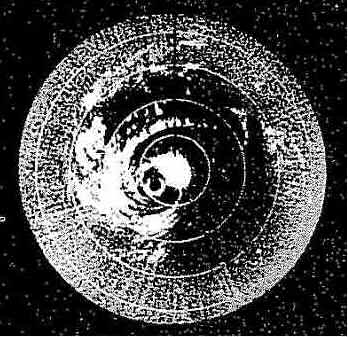 A radar presentation of tropical storm Patsy in the Philippine Sea. The eye clearly shown as a crescent near
the center of the screen. The aircraft lies at the center of the screen and is headed for the break in the
north side of the wall cloud
A radar presentation of tropical storm Patsy in the Philippine Sea. The eye clearly shown as a crescent near
the center of the screen. The aircraft lies at the center of the screen and is headed for the break in the
north side of the wall cloud
What is a typhoon? Well, a hurricane could generate in the Pacific Ocean and be no different from its counter part off the U.S. east coast. If that same Pacific hurricane headed west, over the International Dateline, its name would change and It would become a typhoon spinning dangerous winds and waves through the Pacific Basin.
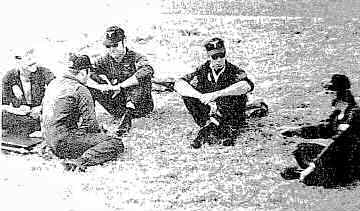 Crew number 12 sits alongside the ramp at Clark Air Base, providing backup launch for another crew.
Crew number 12 sits alongside the ramp at Clark Air Base, providing backup launch for another crew.(R. W. Clarke)
Adequate warning was, and is, the only form of protection; and that was the responsiblilty of a large network of weather reporting facilities which; included a Navy and an Air Force reconnaissance squadron.
I was in the Navy squadron, the typhoon Trackers, and for two years I flew off Guam in the WC-121 Warning Star aircraft searching out vital information on wind intensity and storm location. We were the source of data that became weather warnings for all the countries of the Pacific whenever typhoons approached. The fact that our job required flying into the very center, or "eye," of a typhoon normally interested people wherever we went, but it was never much food for conversation. For someone to be involved In a subject they have to have some knowledge of it, and since we were one of only four squadrons with this duty there was a very limited number of, people around who knew anything about our occupation.
Storm Location
The location of a typhoon is determined by the point of lowest atmospheric pressure for the system. This is not necessarily the same position as the visual (photographed) or the radar eye of the storm, the separation distance between the pressure eye and the radar or visual eye may be several dozen miles. Various atmospheric conditions or geographic obstacles can cause this to occur. Also the position of the pressure eye of the storm at sea level can be different then at 10,000 ft (700 mb) level.An example of these is presented in this 1965 JTWC report (An Example Of False Radar Eye Development) and (An Example Of Differential Movement At Two Levels)
Normally, someone In a group would ask "What's it like?." and unless some moment of inspiration occured, there was no easy way to tell them. It was all a personal experience and fairly hard to talk about. Our job was, very simply, to find and pinpoint, or "fix," typhoons. And despite claims about the extreme accuracy of satellite reconnaissance in determining storm location and intensity, two seasons of going out to find what was really there and where it really was, gives me at least one thing to say—it will be years before an aircraft and crew will not have to penetrate those storms.
Our WC-121s were specially modified versions of the civilian Super Constellation, loaded with electronic equipment for weather research and bulging on top and bottom with radomes. We called them Connies or Willy Victors, from the old designation WV-2; and we generally liked them because they were reliable.
No matter what, the Connies came back. Our mission was distinctive, but whenever we drew notice the initial reason was usually our airplane. Today is an age of straight, angular aircraft that are very efficient. Our "iron bird" was from a different time; last of a breed that started in the thirties and first flew In 1943. It had propellers, it had radomes, and most important of all, it had curves.
Just on looks alone, there was something that created affection about our machine even if the radomes did make it look like a pregnant porpoise. A certain grace went with the air-frame, a soft touch to an iron constitution, and the long landing gear combined with its size to dominate most aircraft on any flight line. Whether you recognized it or not, you could not ignore that airplane whenever It was around.
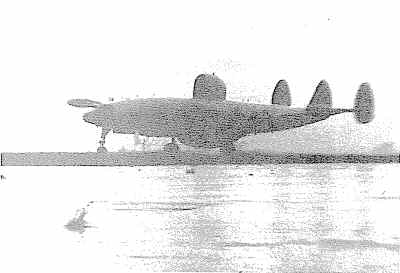 Spray streams behind one of the Typhoon Tracker Willy Victors as it leaves Guam. (Lt. Paul Tsamisis) (USN)
Spray streams behind one of the Typhoon Tracker Willy Victors as it leaves Guam. (Lt. Paul Tsamisis) (USN)
Our arrival at far off bases was more like a ship arrival than an aircraft landing. Even the size of our crews added to the impression since there were always twenty-five or more crew members walking down the gangplank. To be honest, the curved lines of our Willy Victors with the radome on the top and the black line down the side, roughly did resemble a submarine. By present standards our 180 knot cruise airspeed wasn't very fast, so we sort of went along with the joke and called ourselves a fast ship instead of a slow airplane. It usually drew a chuckle from whoever we told it to, but they probably wouldn't have chuckled if they'd been with us at 500 feet over the water desperately trying to keep our faithful old Willy out of the towering waves below us.
Almost the entire year in the Pacific is storm season and our squadron spent that time rotating the standby duty among our nine different crews. Usually, you were warned that a storm deployment was coming at the morning squadron briefing, but more often than I care to remember, the tapping of the "duty driver" on the door in the middle of the night was your key to the fact that your presence was requested, "bag and baggage," for an immediate launch on storm so-and-so.
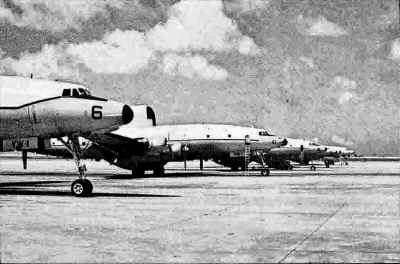 Connies poised on the flight line at NAS Agana, Guam. It was rare to have even as many as four at home at any
one time. (USN)
Connies poised on the flight line at NAS Agana, Guam. It was rare to have even as many as four at home at any
one time. (USN)
Two hours later your sleepy crew had dragged their baggage and tool boxes on board, and your plane rumbled down the runway for a sixteen-hour mission. There was always an initial excitement and tension to launching on a new storm, and for us in the cockpit there was the additional tension of getting our very heavy airplane up off the deck.
There were times when all you could do was call for "Gear up!," and figure whatever was going to happen was a secret shared by your airplane and the runway. Right now our nine Willy Victors are in the boneyard at Davis-Monthan Air Force Base, and they could no more match the performance figures the book claims than the proverbial "man in the moon," Each of those tired old birds spent many years of flying through severe to extreme turbulence and they aren't quite shaped the way that Lockheed Burbank shoved them out the door.
One in particular, Bureau number 145935, was shown ten or more years ago with her same side number, Tango Echo-01, in a history of the Connie. She was in our squadron and she was everyones' pet peeve. Her weight and balance were a mystery, her aerodynamics were losing their "dynamic" and she leaked a lot; but she never let anyone down in a serious way. Like all our Connies, she always came back until the day the ferry crew flew her away to pasture In Arizona.
A lot of our flying was tedious boring of holes through the clear Pacific skies on the way to and from the storm. Six to seven hours might be spent in or near the storm, but that was less than half of a sixteen hour flight. The entire day or night could be spent on the airplane in a fatiguing, grinding. limbo. That wasn't very interesting, but when it came down to the actual storm flying, things changed dramatically.
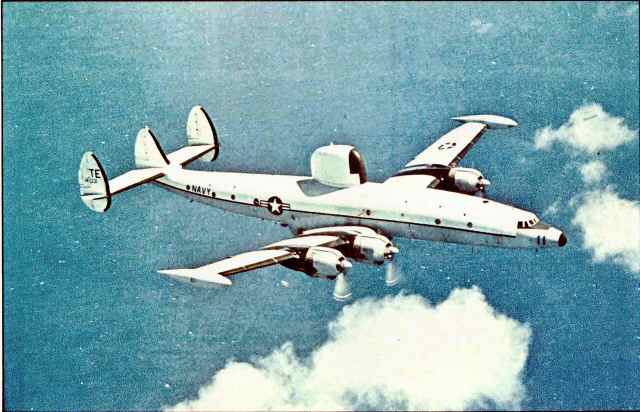 Transport versions were "Connies" or "Super Connies," but with radar they became our
faithful old "Willy Victors," and they always came back.
Transport versions were "Connies" or "Super Connies," but with radar they became our
faithful old "Willy Victors," and they always came back.
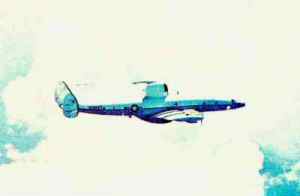 The WC-121 poses against a backdrop of clouds. The
many antennas are a good indication of the volume of electronic gadgets inside.
The WC-121 poses against a backdrop of clouds. The
many antennas are a good indication of the volume of electronic gadgets inside.
The clearest feeling we came away from the typhoons with was a deep respect for nature. Aircraft at many thousands of feet of altitude fly in hundred-knot winds daily, but to fly in that much wind only a few hundred feet above the water with a crab angle of from thirty to forty-five degrees was a revelation. The water would turn a bright green as the wind picked up and when the wind reached a one hundred-knot velocity the surface of the sea was a solid mass of foam that looked as though it were alive with thirty- and forty-foot waves heaving up at you. The plane actually flew through the salt spray.
If you were a pilot you could sometimes see this through the rain, but it wasn't the kind of thing you looked at for very long. Our CICOs (Combat Information Center Officers) were kept very busy providing radar vectors from the picture on their radar scopes, our Meteorologists (Metros) were busy gathering the data we were there to get, and our flight engineers kept us in a working supply of horsepower.
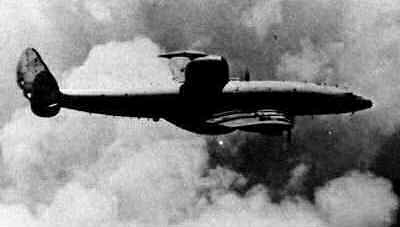 The star of the show was the WC-121 WARNING STAR specially equipped as a weather
research aircraft
The star of the show was the WC-121 WARNING STAR specially equipped as a weather
research aircraft(R. W. Clarke)
Everyone else sat and waited. If you had no specific duty on the penetration, you put on a Mae West, strapped into your seat, and sweated--our air conditioning almost never worked. Someone usually made a wisecrack about Mae Wests being useless, but no one answered. It was plain to see, from looking outside, that survival out there was hopeless when the foam was so thick on the surface that breathing would be as difficult as a controlled ditching would be.
The method of our typhoon penetrations was normally straightforward. The radar, a powerful surface search type, was utilized to vector us around the worst of the precipitation areas since these were usually thunderstorm cells and were very dangerous. Not all of the turbulence was in the cells but the greatest percentage was. Being below the cloud bases at 500 feet kept us out of the worst of the updrafts and turbulence, but sometimes it was necessary to really shove the airplane's nose down and reduce power to remain below the cloud base.
A few times the storm was dry and we could see outside but most of our penetrations were at night so the only person to see much was our Metro who stared at the pool of light our landing light cast on the surface below. If the radar went out, we depended on the Metro for our lives. By observing the angle of the wind ahead of the port wing and the wind's intensity, he could keep us tracking more or less straight ahead.
We might go through some really nasty stuff reaching the "eye" that way. but the Important thing was that we reached it. Once in the relative calm of the "eye" we could usually put the radar back in working order. If trouble was detected early enough the cry was, "ABORT" A preselected heading was the instant response on the flight deck, and we depended on the back end of the plane (the CICO's Metros, and Navigators) to give us constantly corrected abort headings.
All in all, a great deal of coordination was required it took some time to achieve a really experienced crew that could fly the storms and fix the aircraft once it landed, so no massive substitutions took place. A newcomer took his place and learned his job and that of the man ahead of him, before he moved up.
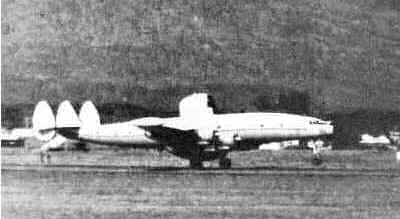 Tango Echo Eleven lifts off Clark Air Base in the
Phillippines on a fourteen hour mission fixing Typhoon Wanda.
Tango Echo Eleven lifts off Clark Air Base in the
Phillippines on a fourteen hour mission fixing Typhoon Wanda.(R. W. Clarke)
We were thorough and professional. We wanted to stay alive as much the next person, but sometimes things didn't work out completely on our side. I cannot speak for the Air Force, but the Navy lost one Coronado flying to a typhoon in the late forties and Neptune to a hurricane in the mid-fifties. We never did lose a Connie. It was the sort of airplane you could count on when events got out of control, but one of the WC-121s never did fly again when it landed in Puerto Rico with injured crewmen, and one came back to Guam with one tip tank missing along with three feet of wing and aileron.
Even the most careful preparation did not eliminate the surprise of the unexpected. When your head starts hitting the top of the cockpit while you're strapped into your seat, and none of the flight, instruments on the panel can be seen, except for a black blur that probably is the ball-bank indicator; all you can do is hang on and begin a left turn into the wind to head back out. While you're doing this, you hope you've got enough airspeed and airplane to complete the turn. One hundred sixteen feet of fuselage can twist incredibly under stress like that, and on this particular occasion a crewman in the rear saw several inches of daylight around the rear hatch.
Sometimes really severe downdrafts developed as the storm's winds swept off the mountains in the Philippines. One plane flew into this and kept descending even after the flight engineer had set full power The old Willy Victor staggered along and eventually pulled up, but there is no way to know exactly how low the plane went--the radar altimeter stopped registering at three hundred feet.
Uncertainty rode with our crews on each storm. One time the plane would ride calmy through large gaps in the feeder bands' that spiraled into the "eye" of the typhoon—the next the plane might be hammered by rain and wind. The rain was always memorable. It sounded like stones rattling off the windscreen and pilots had to yell to each other to be heard at all. It came in sheets at first that gave a rising and falling roar, but as we went deeper into the storm it became steady.
You gradually became accustomed to the intense noise that was accompanied by the roaring of the four big Wright Cyclone engines on our wings. We flew the plane and called for power as needed from the flight engineer. Generally, the briefing was for the engineer to maintain our airspeed between certain limits of ten to fitteen knots, then we would use nose attitude changes to work for both airspeed and attitude while they would juggle throttles back and forth.
A good flight engineer at his control panel was a real joy to watch moving throttles and tending power settings. Some of our engineers had been flying storms for years and were way ahead of our power calls. When the crew had that going for them, they had a well integrated team indeed. Our radar technicians were no slouches either. I remember very well having the radar fail as we broke into the "eye" one time. That left us few choices, so the next hour we spent with that radar set strung up and down the whole length of the plane in littte pieces. Once it was put back together there was still a small jungle of patch cables running all over, but it worked and we got out.
All of the storms left certain memories but Rose and Amy were the two that stood out most In my mind. We chased Rose from Guam to Hong Kong for a week. On one night, as it moved onto the eastern coast of Luzon we clocked 120 knots of wind in close to the "eye." That was also the night that it took us twenty minutes to beat into the center from our Initial Point thirty miles out from the center. This averages to ninety knots—half our normal cruise speed! Rose continued over the Philippines and into the South China Sea to slam into Hong Kong. Our crew had the dubious privilege of making the last fix on her, but we had to do it from a distance with our radar since she was too close to the Communist Chinese coast to permit a penetration.
It was sort of a helpless feeling watching her move in on the city with a "wall cloud" around the eye that showed to be thirty miles thick and solid as a wall of granite. Hong Kong was hurt badly.
Typhoon Amy was different. We had been flying two other storms in the Philippines when she generated southeast of Guam. We received all reports on her as she plastered the Truk lagoon and moved in on Guam, and we wanted to go home badly before the storm hit our own island; but we had to stay in place and finish our present work. Maybe someone did something right, because Amy took one of those unpredictable little turns that storms seem to reserve for special occasions. She skirted west of Guam giving our Island only eighty knots of wind at the most. The next day we got our orders to come home and fly a daytime fix on Amy along the way. By now that storm had us almost in awe.
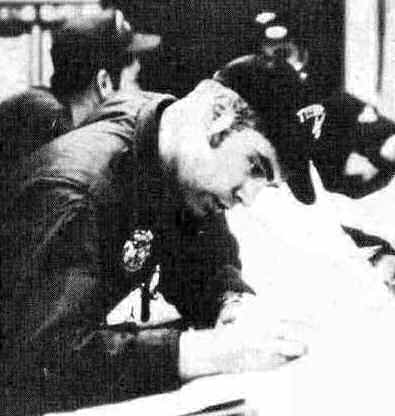 Navigators and pilots lay out the route for a weather recon flight in the South China Sea
Navigators and pilots lay out the route for a weather recon flight in the South China Sea(R. W. Clarke)
She was intense enough that we were not allowed to fly her at low level. Instead, we plowed in at ten thousand feet, blind as bats except for our radar. The radar didn't help much though; all it showed was clouds, solid clouds.
So, with no dodging, we went straight in. Things were pretty tense after hearing about this storm for nearly a week and wondering what she had in store for us; Amy had now received the weather peoples' unofficial designation of Supertyphoon. In the cockpit things were normal with rain and noise; we were in the clouds. Suddenly, it got lighter outside and we catapulted through the wall cloud into one of the grandest sights that any person can ever see. Most of those huge storms had eyes which were filled with scud and a high overcast. Not Amy. She was like a textbook might describe a storm. An eye of perhaps twenty miles diameter ran right from the sea surface to the top of the storm at more than twenty thousand feet.
Inside, there was nothing except absolutely clear sky. The blueness of the sky was incredible and exceeded only by the brilliance of the white clouds sweeping in four-mile high spirals down to the center. It was like flying around inside a fantastic stadium or perhaps a valley in some gargantuan mountain range. No one on the crew said anything for perhaps five minutes as we circled inside that immense and beautiful eye of typhoon Amy. Somebody finally asked if he could go skiing outside but we were too awed to laugh; instead we got down to business and then left.
I talked to the crews that flew into her later. Like us, they measured a sea level pressure of about twenty-six inches of mercury. That is an atmospheric pressure low enough to approximate an altitude of four thousand feet. They also measured winds of one hundred sixty knots. But none of them ever saw her as we did. She had changed, and we were one of the very few groups of men to see a sight like that. Maybe it is just as well that experiences like that are so rare. It tends to make you feel very insignificant, as if you had seen something you weren't supposed to and discovered a secret.
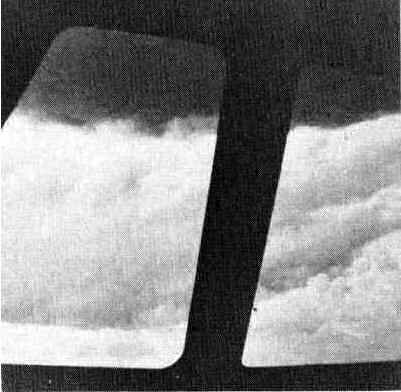 Amy's wall cloud fell off like a four mile high cliff on its southwest side. The view is from the cockpit of
Tango Echo Twelve
Amy's wall cloud fell off like a four mile high cliff on its southwest side. The view is from the cockpit of
Tango Echo Twelve(R. W. Clarke)
Amy and Rose were only two of many storms in those two years and if their impressions are the most vivid, they are far from the only experiences that stand out in my mind. It all amounted to a rare opportunity to experience a unique type of flying with a group of the finest airmen in the world. It is not the kind of thing that you can forget, ever.


